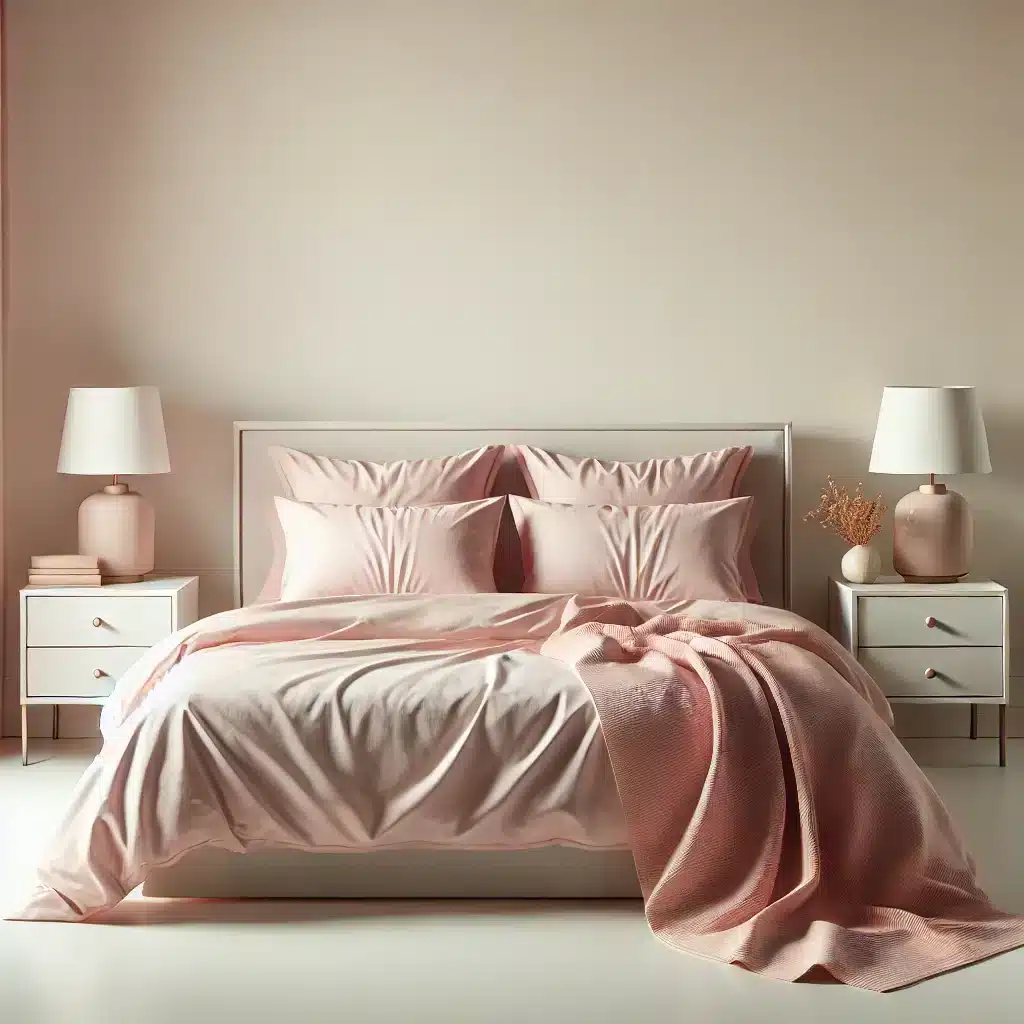Waking up with dry or frizzy hair isn’t always about your shampoo—it might come down to what your head’s resting on. That’s why bamboo pillowcases for hair have become such a popular switch. They’re often used to deal with breakage, frizz, and even scalp irritation.
So, how do they really compare to materials like cotton or silk? And can a simple fabric swap actually help your hair stay healthier overnight?
Sections to Check Out
What Causes Hair Damage While You Sleep?
You might be doing everything right with your shampoo and styling routine, but what about your bedding? If you sleep on cotton or polyester, the rough surface can create friction that weakens your hair over time. Tossing, turning, and going to bed with wet hair can also make matters worse.
Typical signs include:
- Knots or tangles when you wake up
- Frizz or flyaways
- Breakage or loose strands on the pillow
A smoother fabric can help reduce this damage.
How Bamboo Pillowcases Help with Hair
So, what’s the big deal with bamboo pillowcases? It turns out, they do more than just feel nice. They tackle the kind of problems that show up after a rough night’s sleep—like frizz, static, or waking up with that annoying puffball of tangles.
Here’s a closer look at how bamboo actually helps:
Less Friction, Fewer Tangles
They’re noticeably smoother than cotton. That means less tugging and friction while you sleep, which can cut down on tangles and breakage. As HairClub explains, rubbing against rougher fibers like cotton can lead to damage over time.
Helps Retain Moisture
If your hair tends to dry out overnight, especially if it’s been color-treated or is naturally porous, this fabric helps your strands stay softer. Unlike cotton, it won’t soak up your hair’s natural oils or leave it feeling stripped.
Reduces Frizz and Static
Dry indoor air and synthetic fabrics can make hair stick out in every direction. But bamboo is breathable and doesn’t hold static the same way. That helps your hair look smoother when you wake up.
Gentle on Scalp and Skin
Bamboo’s softness is a big plus. It’s gentle against irritated skin, which can be a relief for anyone dealing with acne, eczema, or even just dry patches around the hairline. I switched to bamboo pillowcases a while back, and I’ve honestly noticed less frizz and fewer tangled strands in the morning. It’s one of those small changes that made a big difference over time.
Who Should Consider Bamboo Pillowcases for Hair?
Not every hair type reacts the same way to pillowcase fabrics. But bamboo works especially well for:
- Curly or coily hair: Keeps curls defined and reduces frizz.
- Fine or breakage-prone hair: Less pulling means less fallout.
- Color-treated or processed hair: Helps keep moisture and reduce damage.
- Sensitive or acne-prone skin: Feels soft and won’t trap heat.
- High-porosity hair: Helps lock in hydration overnight.
Is Bamboo the Most Sustainable Material?
Check out the bamboo’s remarkable sustainability as a versatile material!
Bamboo vs Other Pillowcase Materials
Wondering how bamboo really compares to the fabrics you already own? This table lays it out in plain terms.
| Material | Feel | Moisture-Wicking | Breathable | Easy to Wash | Vegan-Friendly |
|---|---|---|---|---|---|
| Bamboo | Smooth | Medium | Yes | Yes | Yes |
| Cotton | Rougher | Low | Medium | Yes | Sometimes |
| Silk | Very smooth | High | Medium | No (handwash) | No |
| Satin | Smooth | Low | Varies | No | No |
| Polyester | Rougher | Low | No | Yes | No |
Bamboo hits that sweet spot—it’s smooth enough to help your hair, but you don’t have to baby it like silk. And unlike polyester, it won’t leave you sweating or clinging to your pillow in the middle of the night.
What to Look for in a Bamboo Pillowcase
Not all bamboo pillowcases are created equal. To get the best results for your hair, it helps to know which features actually matter—and which ones to skip.
Avoid:
- Polyester blends: These cancel out bamboo’s breathability.
- Vague eco-claims: Some products throw around words like “natural” or “eco-friendly” without backing them up. Look for trusted certifications like OEKO-TEX or GOTS to make sure the fabric meets real environmental standards.
- Low thread count: Coarser weaves can still snag hair.
- Viscose if you want antimicrobial properties: Bamboo lyocell keeps more of the plant’s benefits intact.
Bonus: Bamboo lyocell has natural antibacterial properties thanks to a compound called “bamboo kun,” which helps resist odor and bacteria.
Pros and Cons at a Glance
If you’re still on the fence, here’s the quick version: what bamboo gets right, where it falls short, and whether it’s worth tossing your old pillowcase for.
Pros:
- Softer than cotton: Feels gentle and smooth against your hair and skin.
- Less friction and static: Reduces breakage, tangles, and flyaways.
- Keeps more moisture in your hair: Helps retain hydration instead of drying your strands out.
- Gentle on skin: A better choice for sensitive or acne-prone skin.
- Easy to wash and care for: Machine-washable and low-maintenance. Easy to wash and care for
Cons:
- Not quite as silky as real silk: Still smooth, but with a more natural texture.
- Quality can vary depending on the brand: Some feel softer and last longer than others.
- Some blends include synthetics: These can cancel out the breathability and softness.
- Antibacterial benefits depend on the bamboo type: Lyocell retains more than viscose.
Myth Check
There’s a lot of talk online about bamboo pillowcases—but not all of it holds up. Here are a few common myths cleared up.
- Myth: Bamboo doesn’t need any care. — False. It’s low-maintenance, not no-maintenance.
- Myth: Bamboo pillowcases stop all damage. — Not true. They help, but styling habits still matter.
- Myth: Bamboo feels just like silk. — It’s smooth, but not as slick. Easier to care for, though.
How to Make the Most of Your Bamboo Pillowcase
Just using the right pillowcase helps, but pairing it with the right habits can give you even better results overnight.
Pair your pillowcase with a few easy habits:
- Use a silk or wide-tooth comb before bed
- Braid your hair or use a soft scrunchie
- Apply a lightweight leave-in conditioner
- Wash your pillowcase weekly (cold water, no fabric softener)
Who Gets the Most Out of Bamboo Pillowcases?
Anyone can give them a try—but if your hair tends to be a bit high-maintenance, you’ll probably notice the difference sooner. Curly or wavy hair usually keeps its shape better overnight, and fine strands won’t get yanked around as much while you sleep, and I can vouch for that myself.
If you’ve dyed your hair or used a lot of heat tools, bamboo might help you hold onto that much-needed moisture. And if your skin is prone to irritation around your hairline or jaw, switching to something breathable could help calm things down.
They’re also great if you love the feel of silk but not the delicate care it requires. Bamboo gives you that smooth, soft feel, without the drama of hand washing or special detergent.
Want a few recommendations to get started? Check out my list of the best cooling bamboo pillowcase sets that are breathable, soft, and well-reviewed.
Frequently Asked Questions
Still have questions? Here are some of the most common things people ask about bamboo pillowcases and how they work for hair and skin.
- Are bamboo pillowcases good for acne-prone skin? Yes. Bamboo fabric is breathable and naturally gentle, which helps reduce irritation for people with sensitive or acne-prone skin. If you choose a lyocell version, you also get more of bamboo’s original antibacterial properties, which may help limit breakouts around your hairline.
- Are bamboo pillowcases good for your hair? Yes. Bamboo reduces friction, holds in moisture, and prevents tangles while you sleep. That makes it a great option for reducing frizz and breakage, especially for dry or curly hair.
- Is bamboo better than silk for hair? It depends on what matters more to you. Silk feels a bit smoother and more luxurious, but bamboo is easier to care for, breathable, and still very gentle on your hair.
- Is bamboo better than cotton for hair? Yes. Bamboo is smoother and doesn’t absorb your hair’s natural oils like cotton does. That helps you keep more moisture in your hair overnight.
- What pillowcase fabric is best for hair? Experts often recommend silk, satin, or bamboo because they reduce friction and help with moisture retention. Bamboo stands out for being low-maintenance and breathable, too.
- Do they prevent hair loss? Not exactly. Bamboo pillowcases help reduce breakage caused by friction, which can make your hair look fuller over time. But they won’t stop hair loss related to hormones, genetics, or medical conditions.
- Can I use them with wet hair? You can, and they won’t pull or snag like cotton—but it’s still better to let your hair dry a bit before bed. Sleeping with damp hair, no matter the fabric, can lead to tangles or mold buildup in your pillow over time.
- Do they smell weird when new? Some bamboo pillowcases may have a faint scent from packaging or manufacturing. It’s usually mild and disappears after the first wash with cold water and mild detergent.
- Do bamboo sheets help, too? Yes, especially if you have sensitive skin. But when it comes to hair protection, your pillowcase matters more since that’s where your head rests and rubs for hours each night.
- What are the downsides of bamboo pillowcases? They aren’t quite as smooth as silk, and not all bamboo is the same—some cheaper brands mix in synthetics or use rougher weaves. Look for ones made from bamboo lyocell with clear certifications.
A Simple Upgrade With Real Benefits
No, it’s not a magic fix—but swapping to a bamboo pillowcase can make your mornings a lot easier. Bamboo pillowcases for hair aren’t just a trend—they’re a simple, practical swap that helps many people deal with frizz, breakage, and overnight dryness. Fewer tangles. Less pillowhead drama. And a lot more comfort against your skin. It’s the kind of change you don’t realize you needed until you stop waking up with that dry, puffy mess on your head.
It’s low-maintenance, feels great, and helps your hair stay in better shape while you sleep. Honestly, for something that takes zero effort once it’s on the bed, it pulls more weight than you’d expect.
Looking to upgrade your whole bedding setup? My guide to eco-friendly bamboo bedding breaks down the best options for a cooler, cleaner night’s sleep.

Kristin is the founder of Eco Bamboo Living. She shares honest, research-backed guides and product reviews to help readers find bamboo products that are truly sustainable, practical, and worth bringing into their homes.

